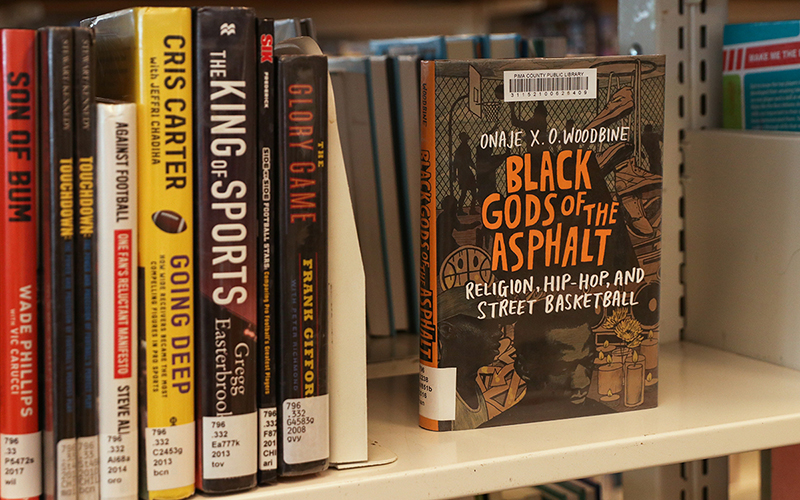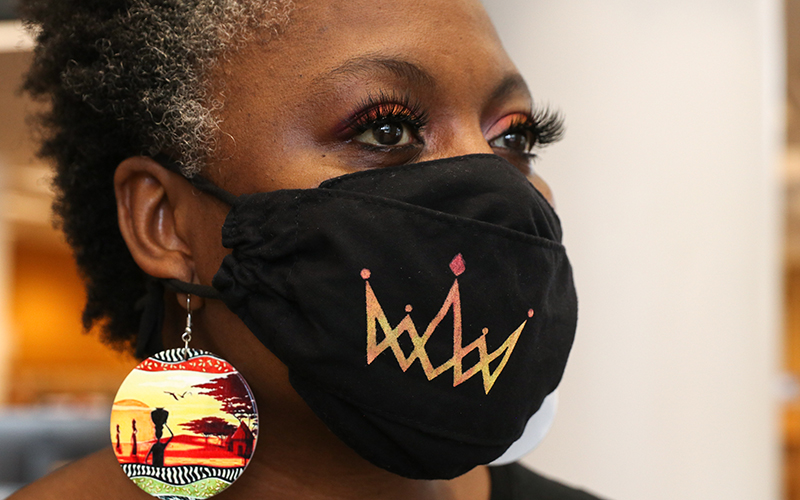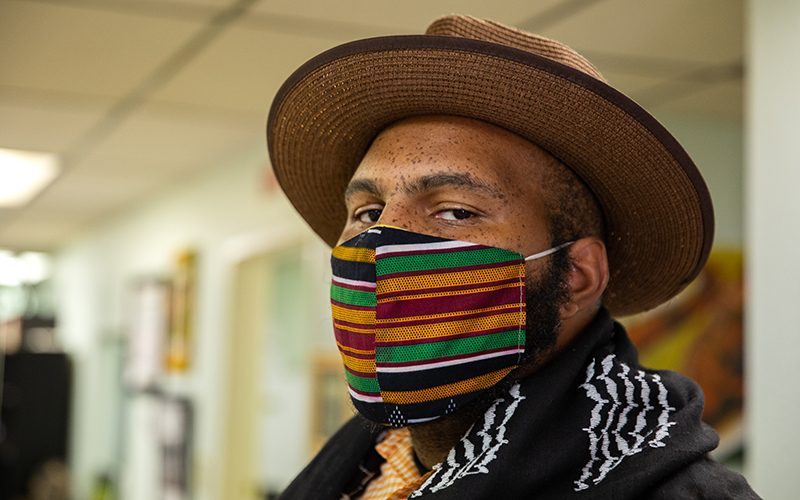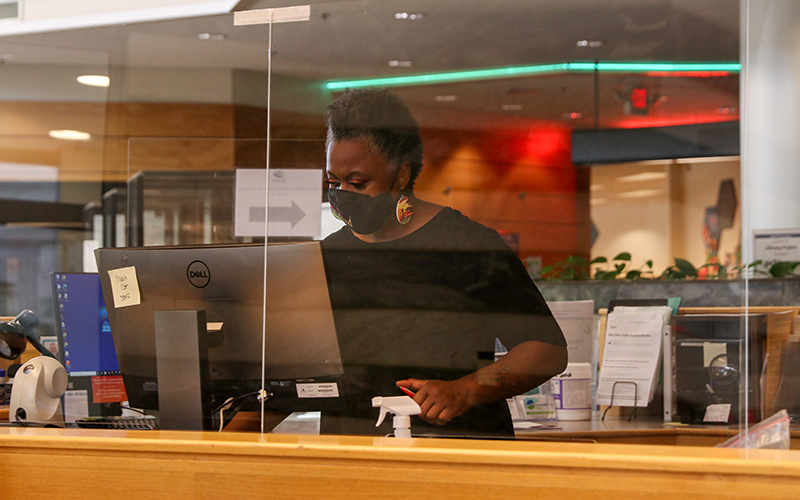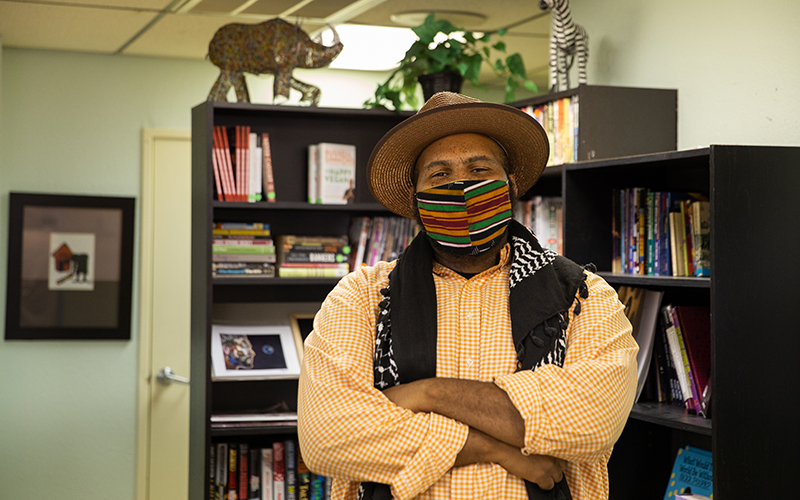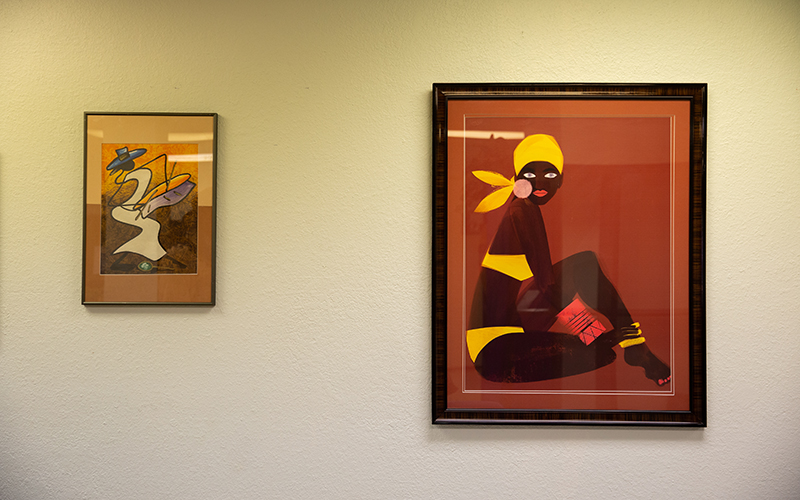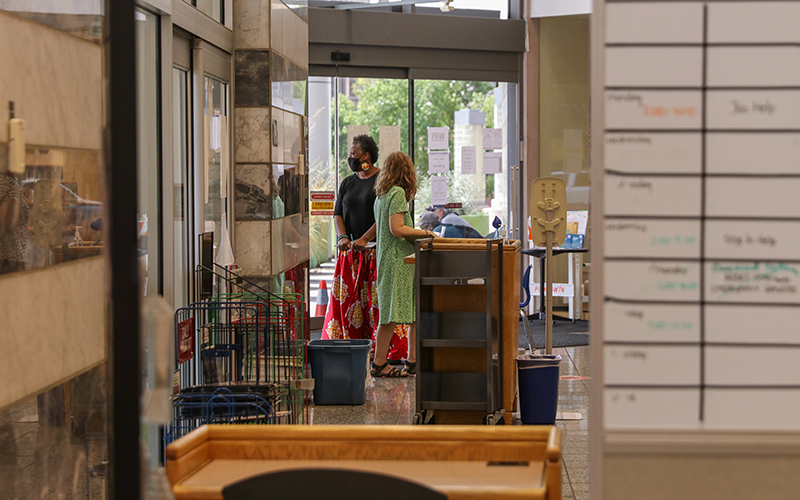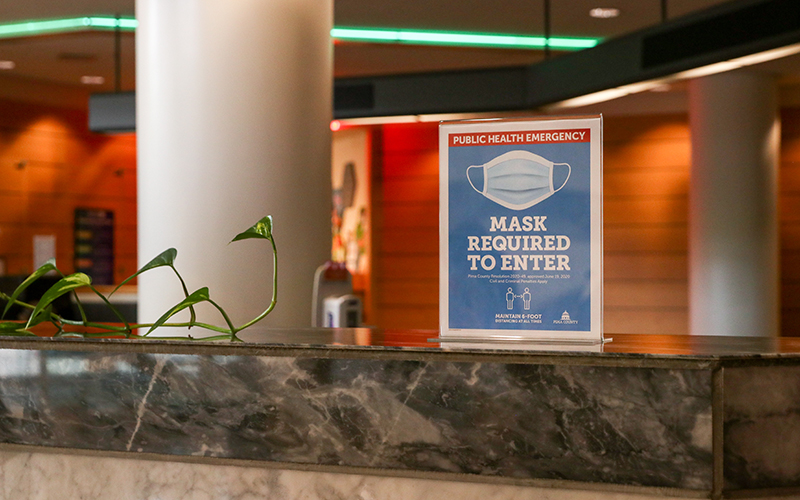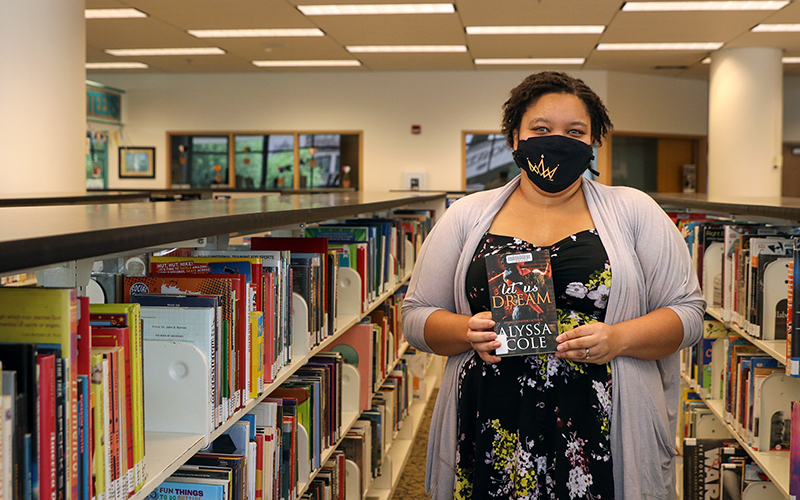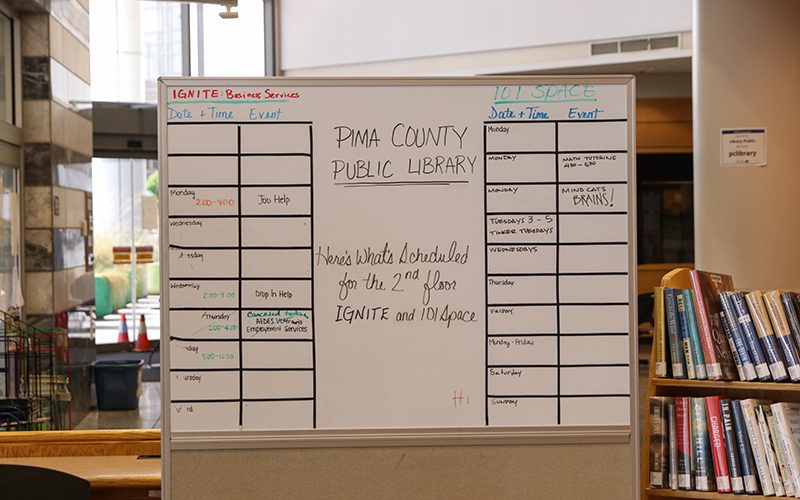- Slug: BC-CNS-Black Libraries,1960
- 12 photos available
- Long-form video, Phillips audio, Nervis audio available.
By Haillie Parker and Allie Barton
Cronkite News
TUCSON – One Saturday morning, a mother and father take their daughter to the public library for the first time. The young girl walks around her parents to look at the librarian at the front desk, gazing at another Black person in a public space that’s usually occupied by white people.
“Do you work here?” she asks.
“I do,” the librarian answers.
“That makes me so happy,” the girl says.
Tenecia Phillips, branch manager of the Joel D. Valdez Main Library in Tucson, tears up at the memory. It’s one of many such moments she has shared with Black families over her nine years with the Pima County Public Library.
“This isn’t a job, this is a calling to me,” said Phillips, who chairs Kindred, a program to diversify Black staffing, events and the collections in Pima County branch libraries.
Although the program is only 3 years old, its founding principles trace to decades of cultural invisibility. The need for better representation of the Black community in libraries, publishing, bookstore ownership and on bestseller lists has gained urgency through a recent wave of social justice movements across the nation.
COVID-19 has reshaped Kindred’s approach to in-person programs to connect Tucson’s Black community like kindred spirits, although it continues to add new titles to its shelves.
In Phoenix, Arizona’s only Black-owned bookstore opened its first online shop to accommodate a swell of orders from new customers, hungry for social commentary as such titles as “How to Be an Anti-Racist” are flying off shelves and topping the New York Times Nonfiction Best Sellers. And one Arizona publisher has welcomed a ripple of first-time authors since March, contributing to a clientele that is more than 98% Black.
Spurred by the recent killings of George Floyd, Breonna Taylor, Ahmaud Arbery and other Black Americans, recognition and representation are at the forefront of society. Some have turned inward, educating themselves on how they’ve contributed to America’s history of systemic racism and reimagining an equitable society.
Phillips, who grew up in Tucson and self-identified as a “nerd,” spent her childhood bonding over books with her father. She said she felt safe in the library – despite rarely seeing other Black people there – and has long understood the importance of diversifying the library system, a profession that is overwhelmingly female and nearly 88% white.
The American Library Association recognizes the racial disparity among librarians and the materials patrons have access to in public collections, especially considering the racial makeup of many communities served by public libraries. Leaders apologized for the systemic racism that threads library systems and in 1970, created the Black Caucus of the American Library Association to help bridge the gap – a goal that’s still in progress.
Operating independently from the American Library Association, the Black Caucus hinges on the concept of community connection on and off the page.
Shauntee Burns-Simpson, president of the Black Caucus, said that when the connection between a library and its community members is lost, “they probably won’t visit the library and it’ll just be another building on the block.
“You have to prepare your community for the bigger world,” she said. “And if the libraries aren’t having materials that reflect that, that’s the disservice that we’re doing to the community.”
Access to diverse titles is still a struggle for library patrons, and there is plenty of room to add inclusion, said Wayne A. Wiegand, an F. William Summers professor of Library Information Studies at Florida State University.
“Librarians can only purchase the books that publishers publish,” Wiegand said. “If publishers continue to publish books largely for the dominant culture, then those residing outside that dominant culture are always at a competitive disadvantage.”
Burns-Simpson said each library maintains its own process for purchasing materials, but the one constant among all librarians is that they must have their “finger on the pulse” of different communities at all times.
“There was something about seeing myself filling the description and knowing that this author got it,” Phillips said, reflecting on a story she read as a child. “You get that from books, you also get that when you see people who look like you reflected in spaces that you enter.”
Phillips, who’s now back at the library where she began her career, spent three years in her profession before ever working alongside a fellow person of color. Even today, there are only two other Black staff members at the main library and only one other Black librarian in the Pima County system in a community that is 5.1% Black.
Phillips’ childhood familiarity with Tucson’s Black community and a history of literary exclusivity laid the foundation for two of Kindred’s goals: to expand and retain employees of color and to welcome inclusion to its bookshelves.
The team has made strides through weeks of programs for Black History Month including Black storytime and talks led by prominent local people of color on topics like Black history in the Southwest, female entrepreneurship, and the theory of a quilt code for the Underground Railroad. The events, centered around Black history, culture, and experiences, were open to everyone.
“It may not be anything you can understand or have ever experienced, but you can support and you can encourage and you can use your privilege in a way that helps that goal be accomplished,” Phillips said. “And I think that’s really important, especially right now.”
Kindred also received a grant to distribute 200 copies of Octavia E. Butler’s “Parable of the Sower,” along with study guides to encourage discussion. And, before the pandemic, Kindred leaders were planning a presentation at the Black Caucus of the American Library Association’s national conference to show other Black librarians that even a small team can accomplish something special.
Pima County has mirrored the Kindred example to expose the lack of accessible materials written by and for LGBTQ+, Indiginous and Latino patrons, launching such new collections as the Frank De La Cruz collection, which focuses on U.S. and Mexico borderland history and culture.
Other libraries have embraced similar goals.
Arizona State University President Michael Crow in September allocated a stream of funds for library archives as part of the school’s commitment to Black students, faculty and staff. The funds kept a three-year-old $450,000 grant for the Community-Driven Archive Initiative from expiring.
“Historically, this type of equity and inclusion work within the library archive field has never been a priority. It’s always been seen as a token outreach or an initiative to meet a yearly quota,” said Nancy Godoy, who heads archives and is associate archivist of the Chicano Research Collection at ASU Library.
Godoy said she was aware of inequities in historical archives long before she started working at the library in 2012.
Latinos comprise more than 30% of Arizona’s population but appear in less than 2% of all archives. Godoy, a Latina herself, led the grant-based initiative to diversify ASU archives by fundraising and teaching members of diverse communities how to collect old photos, news clips, letters, videos and other family history in a state that is about 40% non-white but often forgets the contributions of Blacks, Latinos and Indigenous people to its history.
Black owned bookstores also are receiving attention with the heightened focus on racial justice.
“It’s almost like a renaissance of people understanding the time that we’re in and the fact that we have to really go for it,” said Ali Nervis, co-owner of Grassrootz Books and Juice Bar in Phoenix, the only Black-owned bookstore in the state. “If we can be a resource, if we can be of any assistance of that process or the process that comes immediately after, that’s why we exist.”
Grassrootz opened in November 2019 in Phoenix’s Eastlake neighborhood in the AFRI-Soul marketplace, a space known for housing Black entrepreneurs and small businesses. Paintings by Black artists adorn the walls like pieces of a jigsaw puzzle, gold and royal blue patterned clothing hang on racks through the midsection of the building.
Grassrootz grew from a small hallway space into one of the larger common areas. In seven months, it twice experienced an outpouring of demand – when COVID-19 spurred stay-at-home orders, and again after George Floyd was killed on May 25.
To adapt, Nervis launched several “firsts.” He created an online storefront and rented books to address the community’s growing appetite for reading while in quarantine. He then expanded his stock, pulling in new titles of historical and social commentary, fiction, literature and self-help, in addition to the children’s books that once drove business.
“We have to be intentional,” Nervis said. “We’re highly focused on the historical aspect and a lot of social commentary, but I think it’s important that (diversity) runs the gamut when it comes to fiction and literature.”
Nervis said he attributes Grassrootz’s growing pool of customers to quiet activism, as people from around the country show their support for Black businesses. Nervis wants Grassrootz to help sustain the demand for conversations and actions surrounding social justice, racism and history.
Such books as Martin Luther King, Jr. ‘s “Where Do We Go From Here,” “The New Jim Crow” and “The Color of Law” dominate the shelves. Nearby volumes include a slew of children’s books – the store’s original primary genre – many written and self-published by local Black authors.
“People are realizing they don’t have to go to traditional publishing companies,” said Shamirrah Hill, a former children’s theater teacher turned children’s book author and co-founder of the Phoenix company DG Self-Publishing.
Hill said her business has helped about 300 authors so far, and that her number of clients – predominantly Black female professionals – grew in the wake of COVID as well.
Those who felt that publishing a book was unattainable or who were previously told their ideas were “too niche, too Black, or too religious” now are finding creative freedom and confidence through self-publishing, Hill said.
“They can actually write their story and tell it the way that they want to tell it, and they don’t need anyone’s permission but their own,” she said.
The publishing industry, like many industries in the U.S., is not diverse. Most of the people who work at the top companies are 76% white and 74% female, according to Lee & Low Books’ 2019 Diversity Baseline Survey. Authors of color also are rare and often paid less, which spawned a hashtag #PublishingPaidMe. Some companies are now supporting the creation of new literary genres that are more diverse.
Hill said the lack of representation for the Black community is most apparent in children’s books, most of which depict white characters and struggle to properly illustrate Black children and young people of color.
“Our noses are shaped a certain way, our lips, our hair is a certain way. It’s really important,” Hill said. “We don’t want our hair and eyes, nose and lips messed up, but it’s just really challenging, even for Black artists.”
Hill wrote a book, “The Shy Monster,” about a young Black schoolgirl. Its illustrations feature children and teachers of color.
Phillips, the Tucson librarian, remembers one of her first childhood experiences of seeing an illustration of another Black child in a book about a young boy getting a haircut.
“I wore my hair short for many years. There’s just something about getting a fresh haircut — especially if you wear your hair short,” Phillips said. “I remember reading that and thinking, ‘I know the feeling he’s describing, I feel that every time.’”
Such memories guide Phillips as she shapes Kindred’s goals. But a larger presence drives her purpose.
“I stand on the shoulders of Black librarians in other cities and other counties across time, “ she said. “I want to make them proud, but I also want to send the message that this is a space where we belong. We are needed in these spaces.”
For more stories from Cronkite News, visit cronkitenews.azpbs.org.
^__=
One of Kindred’s founding goals is still in progress: diversifying the authors on Tucson library shelves to mirror the city’s own diverse community. (Photo by Allie Barton/Cronkite News)
Tenecia Phillips, branch manager of the Joel D. Valdez Main Library in Tucson, chairs Kindred, a program to diversify Black staffing, events and the collections in Pima County branch libraries. (Photo by Allie Barton/Cronkite News)
Ali Nervis, co-owner of Grassrootz Books and Juice Bar in Phoenix, the only Black-owned bookstore in the state. (Photo by Allie Barton/Cronkite News)
“These women have become my family,” said Tenecia Phillips of the Kindred team. “We have supported each other through so many things.” (Photo by Allie Barton/Cronkite News)
Bookstore owner Ali Nervis said he was inundated with orders for books like “The New Jim Crow” after the death of George Floyd. “It’s like a renaissance of people understanding the time that we’re in.” (Photo by Allie Barton/Cronkite News)
Grassrootz Books and Juice Bar got its start as part of the AFRI-Soul Marketplace in Phoenix in November 2019. Paintings by Black artists adorn the walls, while gold and royal blue patterned clothing hang on racks through the midsection of the building. (Photo by Allie Barton/Cronkite News)
Tenecia Phillips welcomes patrons to the Pima County Main Library one by one, takes their temperatures before they enter and makes sure that each wears a mask. (Photo by Allie Barton/Cronkite News)
New safety measures were implemented in Pima County libraries after the global spread of COVID-19. (Photo by Allie Barton/Cronkite News)
Jessica Pryde works for the Pima County Main Library and contributes to the Kindred team. (Photos by Allie Barton/Cronkite News)
Tenecia Phillips works for the Pima County Main Library and contributes to the Kindred team. (Photo by Allie Barton/Cronkite News)
Angela Harper works for the Pima County Main Library and contributes to the Kindred team. (Photo by Allie Barton/Cronkite News)
Connecting with patrons of the Pima County Main Library looks different during the pandemic for Tenecia Phillips and the library’s staff. (Photo by Allie Barton/Cronkite News)
